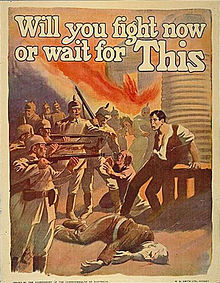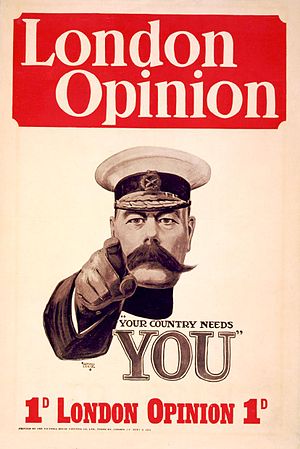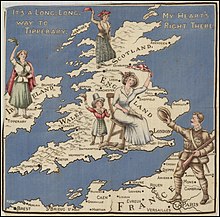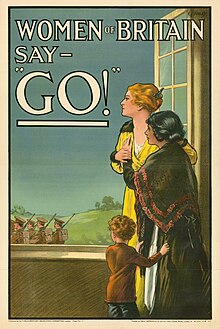
Propaganda is communication that is primarily used to influence or persuade an audience to further an agenda, which may not be objective and may be selectively presenting facts to encourage a particular synthesis or perception, or using loaded language to produce an emotional rather than a rational response to the information that is being presented. Propaganda can be found in a wide variety of different contexts.

James Bryce, 1st Viscount Bryce,, was a British academic, jurist, historian, and Liberal politician. According to Keoth Robbins, he was a widely traveled authority on law, government, and history whose expertise led to high political offices culminating with his successful role as ambassador to the United States, 1907–13. His intellectual influence was greatest in The American Commonwealth (1888), an in-depth study of American politics that shaped the understanding of America in Britain and in the United States as well.

George Edward Creel was an American investigative journalist and writer, a politician and government official. He served as the head of the United States Committee on Public Information, a propaganda organization created by President Woodrow Wilson during World War I.

A war economy or wartime economy is the set of contingencies undertaken by a modern state to mobilize its economy for war production. Philippe Le Billon describes a war economy as a "system of producing, mobilizing and allocating resources to sustain the violence." Some measures taken include the increasing of Taylor rates as well as the introduction of resource allocation programs. Approaches to the reconfiguration of the economy differ from country to country.

The Committee on Public Information (1917–1919), also known as the CPI or the Creel Committee, was an independent agency of the government of the United States under the Wilson administration created to influence public opinion to support the US in World War I, in particular, the US home front.

The United Kingdom was a leading Allied Power during the First World War of 1914–1918. They fought against the Central Powers, mainly Germany. The armed forces were greatly expanded and reorganised—the war marked the founding of the Royal Air Force. The highly controversial introduction, in January 1916, of conscription for the first time in British history followed the raising of one of the largest all-volunteer armies in history, known as Kitchener's Army, of more than 2,000,000 men. The outbreak of war was a socially unifying event. Enthusiasm was widespread in 1914, and was similar to that across Europe.

The Rape of Belgium was a series of systematic war crimes, especially mass murder and deportation, by German troops against Belgian civilians during the invasion and occupation of Belgium in World War I.

The Four Minute Men were a group of volunteers authorized by United States President Woodrow Wilson to give four-minute speeches on topics given to them by the Committee on Public Information (CPI). In 1917–1918, over 750,000 speeches were given in 5,200 communities by over 75,000 accomplished orators, reaching about 400 million listeners. The topics dealt with the American war effort in the First World War and were presented during the four minutes between reels changing in movie theaters across the country. The speeches were made to be four minutes so that they could be given at town meetings, restaurants, and other places that had an audience.
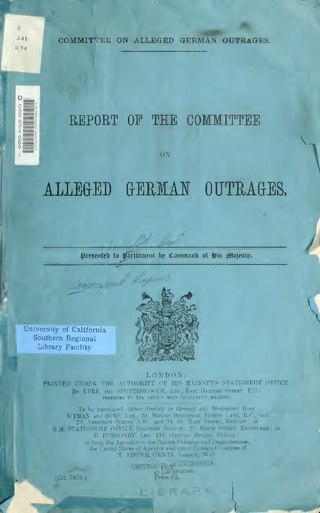
The Committee on Alleged German Outrages, often called the Bryce Report after its chair, Viscount James Bryce (1838–1922), is best known for producing the "Report of the Committee on Alleged German Outrages," published on 12 May 1915. The report is seen as a major propaganda form that Britain used in order to influence international public opinion regarding the behaviour of Germany, which had invaded Belgium the year before. It was the first significant publication from the War Propaganda Bureau at Wellington House.

This list contains a selection of books on World War I, using APA style citations.

Britain re-created the World War I Ministry of Information for the duration of World War II to generate propaganda to influence the population towards support for the war effort. A wide range of media was employed aimed at local and overseas audiences. Traditional forms such as newspapers and posters were joined by new media including cinema (film), newsreels and radio. A wide range of themes were addressed, fostering hostility to the enemy, support for allies, and specific pro war projects such as conserving metal and growing vegetables.
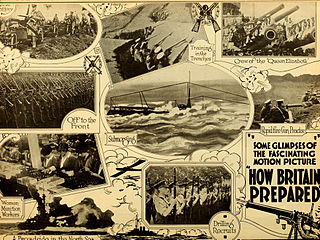
In the First World War, British propaganda took various forms, including pictures, literature and film. Britain also placed significant emphasis on atrocity propaganda as a way of mobilising public opinion against Imperial Germany and the Central Powers during the First World War. For the global picture see Propaganda in World War I.
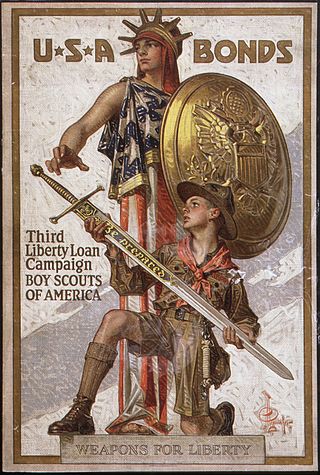
During World War I, the United States saw a systematic mobilization of the country's entire population and economy to produce the soldiers, food supplies, ammunitions and money necessary to win the war. Although the United States entered the war in April 1917, there had been very little planning, or even recognition of the problems that Great Britain and the other Allies had to solve on their own home fronts. As a result, the level of confusion was high in the first 12 months.

The United States entered into World War I in April 1917, more than two and a half years after the war began in Europe.

The United States declared war on the German Empire on April 6, 1917, nearly three years after World War I started. A ceasefire and armistice were declared on November 11, 1918. Before entering the war, the U.S. had remained neutral, though it had been an important supplier to the United Kingdom, France, and the other powers of the Allies of World War I.
The home front during World War I covers the domestic, economic, social and political histories of countries involved in that conflict. It covers the mobilization of armed forces and war supplies, lives of others, but does not include the military history. For nonmilitary interactions among the major players see Diplomatic history of World War I.
Atrocity propaganda is the spreading of information about the crimes committed by an enemy, which can be factual, but often includes or features deliberate fabrications or exaggerations. This can involve photographs, videos, illustrations, interviews, and other forms of information presentation or reporting.

The history of Belgium in World War I traces Belgium's role between the German invasion in 1914, through the continued military resistance and occupation of the territory by German forces to the armistice in 1918, as well as the role it played in the international war effort through its African colony and small force on the Eastern Front.

Propaganda is a form of communication that aims to shape people's beliefs and behaviors. It is typically not impartial and used to promote a specific agenda or perspective and is often biased, misleading, or even false. Propagandists use various techniques to manipulate people's opinions, including selective presentation of facts, the omission of relevant information, and the use of emotionally charged language.
The diplomatic history of World War I covers the non-military interactions among the major players during World War I. For the domestic histories of participants see home front during World War I. For a longer-term perspective see international relations (1814–1919) and causes of World War I. For the following (post-war) era see international relations (1919–1939). The major "Allies" grouping included Great Britain and its empire, France, Russia, Italy and the United States. Opposing the Allies, the major Central Powers included Germany, Austria-Hungary, the Ottoman Empire (Turkey) and Bulgaria. Other countries also joined the Allies. For a detailed chronology see timeline of World War I.



